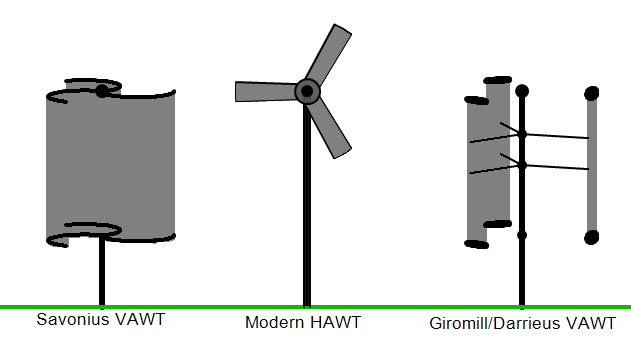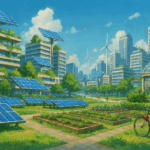The Grid Is Fragile. Your Balcony Isn’t.
As climate anxiety spreads and utility bills climb, a growing number of people are asking a deceptively simple question: can I generate my own power—from my own apartment?
Balcony-based microgeneration is more than a solarpunk science fair experiment. It’s a smart way to lower your carbon footprint and your electric bill at the same time. And thanks to plummeting prices for solar panels, better wind turbines, and smarter batteries, the tech is already here.
This isn’t off-grid fantasy—it’s just good math.
Curious what solarpunk really means? It’s more than just a vibe. It’s a growing movement that blends renewable tech, ecological design, and radical community-building. Learn more about the roots and values of the solarpunk ethos in our guide: What Is Solarpunk? A Beginner’s Guide to the Movement Redesigning the Future
How Much Energy Does an Urban Apartment Use?
To understand what a cleaner future could look like in practice, let’s start with the energy use of a typical two-bedroom apartment in the U.S., which consumes about 20–25 kilowatt-hours of electricity per day. At an average cost of around $0.15 per kilowatt-hour, that translates to a monthly electricity bill of roughly $90–$110.
Before we dive into what’s possible, it’s helpful to understand where our household electricity actually comes from today. In the United States, as of 2023, approximately 60% of electricity generation still comes from fossil fuels—primarily natural gas (39%) and coal (19%). Renewable sources such as wind (11%), solar (4.8%), and hydroelectric (6.1%) collectively account for around 22%, while nuclear power contributes an additional 18%.
That means the majority of household electricity is still derived from carbon-emitting sources. While some states like California, Washington, and New York have cleaner mixes, the national grid is still heavily reliant on fossil fuels. As a result, even flipping a light switch in an urban apartment often draws on power from natural gas or coal.
[Source: U.S. Energy Information Administration (EIA), 2023 Electricity Generation Report]
Wind, Sun, and Storage on a Balcony
Imagine stepping out onto your balcony as the sun begins to shine. You sip your morning coffee and check your potted garden. You hear the gentle hum of a vertical wind turbine spinning gently as your caffeinated concoction begins to take effect. You take a seat and read the morning news as the small solar panels attached to your railings silently track the sun as it slowly rises across the skyline. What was once a passive concrete space now grows your essential vegetables and powers a majority of your apartment’s electrical needs.
While rooftop solar panels are becoming more common on residential buildings, a quieter—and often overlooked—innovation is beginning to turn heads: the vertical-axis wind turbine (VAWT). These compact, low-noise devices are designed to thrive in turbulent, multidirectional wind conditions like those found between urban high-rises. When paired with balcony-mounted solar panels and connected to home battery systems, they represent a truly decentralized energy solution that doesn’t rely on traditional rooftop access.

This hybrid approach is particularly valuable in cities where residents often don’t control their building’s roof. By reclaiming balcony railings and vertical surfaces, apartment dwellers gain direct agency over their power production. It’s a powerful shift: each home becomes an energy-generating node contributing to local resilience and global decarbonization.
Unlike traditional wind turbines with massive horizontal blades, VAWTs have a compact, upright design that captures wind from all directions. This makes them ideal for cities, where wind patterns are irregular and space is limited. VAWTs are quieter, easier to mount on vertical structures, and require less clearance, making them perfect candidates for balconies, rooftops, and building facades.
Crunching the Costs (and the Payback)
To offset a significant portion of that usage, residents could install a compact balcony-mounted VAWT capable of producing 100–400 watts, generating roughly 3–6 kilowatt-hours per day depending on wind conditions. Turbines of this sort range in cost from $400 to $1,000 and can be installed on sturdy balcony railings.
Supplementing wind power with solar makes sense. Two 400-watt solar panels mounted to a balcony or nearby structure could produce an additional 2–3 kilowatt-hours per day. Combined, the system could supply up to half of the apartment’s energy needs. These solar panels and mounting kits cost about $500–$600.
Battery storage is essential for storing excess energy produced during peak sunlight or wind periods. Including a charge controller (a device that regulates voltage and current coming from solar panels or turbines to prevent battery overcharging), inverter (a device that converts stored DC battery power into usable AC electricity for home appliances), and system management tools, the total cost for battery and management might range from $4,000 to $6,000.
In total, the full system would cost between $5,500 and $8,600, with minor maintenance costs of $100–$300 annually.
With this configuration covering roughly 50–75% of an apartment’s daily energy use, users can expect to save about $50–$80 per month on electricity. That equates to $600–$1,000 annually in savings, meaning the system could pay for itself in 6 to 10 years. The timeline could be even shorter if electricity prices rise, local solar incentives are available, or the system is installed collectively for a multi-unit building.
The Tech That’s Making It Easier
To make these urban renewable energy solutions more accessible, technological advancements are already underway. The cost of batteries is expected to drop as newer materials like sodium-ion and solid-state technologies enter the market. These innovations promise to be more affordable, longer-lasting, and safer than current lithium-based options.
Installation complexity is another barrier. Emerging plug-and-play kits that combine foldable solar panels, turbines, and preconfigured battery storage with app-based control could make setup far easier. Mass production and streamlined designs would reduce costs and bring energy autonomy within reach for more urban residents.
Urban wind capture itself is improving. Engineers are developing bladeless VAWTs, low-wind-start models, and aerodynamic structures that better handle turbulent city airflow. These upgrades could make wind power more efficient and viable in denser environments.
Meanwhile, smarter grid integration policies such as net metering (a billing system that credits homeowners for excess solar or wind energy they send back to the grid), virtual net metering (a system that allows shared renewable energy credits across multiple tenants or units in a building), peer-to-peer energy trading (a decentralized system where individuals can directly buy and sell excess renewable energy to one another), and smart inverters (advanced inverters that communicate with the grid to optimize energy flow and support grid stability) allow users to not only reduce their bills but contribute energy back to the local grid. This redefines the home from passive energy consumer to active energy participant.
From Apartment to Micro Power Plant
While individual balconies can host small-scale systems, entire apartment buildings can operate as micro power plants—known as Virtual Power Plants (VPPs) or Distributed Energy Resource (DER) systems. These smart, networked setups aggregate solar panels, wind turbines, and battery storage across a whole building to power not just single apartments but the entire complex.
Imagine a mid-rise solarpunk apartment building covered in vertical gardens and equipped with rooftop solar panels, vertical-axis wind turbines on every balcony, and shared battery storage in the basement. Excess power from sunny days and windy nights is not only used internally but can also be sold back to the grid or shared with nearby homes.

Let’s imagine a speculative model: a 20-unit apartment building designed from the ground up with solarpunk energy infrastructure. Each apartment has its own balcony-mounted vertical-axis wind turbine and a pair of solar panels. In addition, the building’s roof is outfitted with 40 high-efficiency solar panels (each producing 400 watts), contributing a robust base of energy to the shared grid. Combined, each apartment can generate about 5–8 kWh per day from its personal systems, while the rooftop array adds roughly 50–60 kWh per day total, depending on seasonal sunlight conditions.
A shared battery storage room in the basement holds 200 kWh of lithium iron phosphate capacity—enough to power the entire building during peak demand or outages. Assuming an average apartment uses 20–25 kWh/day, this setup can offset between 50–70% of the building’s total energy needs.
Cost-wise, each apartment unit’s personal setup (turbine, solar panels, inverter, and small storage) would cost around $6,000. Multiply that by 20 units = $120,000. The rooftop solar array might add another $25,000, and shared battery storage and management systems another $80,000. Add installation, permits, and infrastructure costs, and the total estimated investment lands around $250,000–$300,000.
If each unit saves $80–100/month in electricity (about $1,200 annually), the building saves $24,000 per year total. That means the system could pay itself off in 12–15 years, faster with subsidies or net metering. After that, energy becomes essentially free—minus occasional maintenance costs. It’s an urban energy farm wrapped in a modern residential shell.
Policies that support this future include net metering and virtual net metering, allowing individuals or buildings to sell power back to the grid and distribute credits across residents. Federal and state tax incentives further reduce upfront costs, while updated green building codes encourage renewable integration in new developments.
The Future Is Solarpunk
This kind of microgeneration doesn’t just offer cost savings—it’s a redefinition of how we relate to our environment. Each apartment becomes a micro-node in a larger web of distributed, democratic energy. This lifestyle champions autonomy, resilience, and a reconnection with the rhythms of nature. Solarpunk isn’t merely an aesthetic—it’s a system of values made real through practical design. The blending of ecological technology and communal ethos signals a radical departure from centralized, extractive energy systems. It’s a lifestyle and philosophy that unites design, ecology, and community.
Turning your balcony into a power station is just one part of the rebellion. From seed swaps to tool libraries, solarpunks are building a better future with their bare hands—and their neighborhoods. Read our practical urban solarpunk guide: Solarpunks Give a F**k: The Urban Rebellion Guide to Greener Cities
Picture a building where your apartment doesn’t just consume power—it helps manage the city’s energy. Automated systems balance loads, neighbors share power, and the rooftop doubles as a food-producing greenhouse. With the right tech and policies, solarpunk isn’t just a style—it’s infrastructure. The result? A climate-resilient living complex that doesn’t just reduce carbon—it produces autonomy.
In the face of grid fragility, climate anxiety, and rising costs, balcony-based microgeneration isn’t just a cool idea—it’s a quiet rebellion. Pairing vertical wind turbines with solar panels turns your urban home into a node of autonomy. The grid won’t save you. Your balcony might. Welcome to the solarpunk rebellion—quiet, beautiful, and very much alive.
Want to dream bigger? These visionary novels offer blueprints for the world we could build—if we start now: 10 Essential Solarpunk Books to Inspire a Brighter Future








